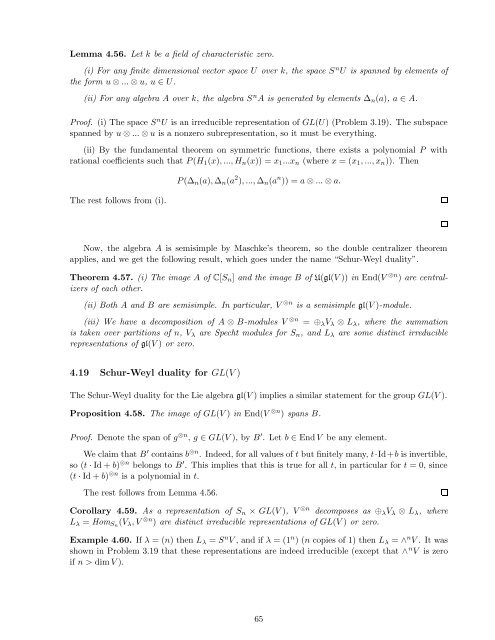Lecture notes for Introduction to Representation Theory
Lecture notes for Introduction to Representation Theory
Lecture notes for Introduction to Representation Theory
Create successful ePaper yourself
Turn your PDF publications into a flip-book with our unique Google optimized e-Paper software.
Lemma 4.56. Let k be a field of characteristic zero.<br />
(i) For any finite dimensional vec<strong>to</strong>r space U over k, the space S n U is spanned by elements of<br />
the <strong>for</strong>m u ... u, u U.<br />
(ii) For any algebra A over k, the algebra S n A is generated by elements n (a), a A.<br />
Proof. (i) The space S n U is an irreducible representation of GL(U) (Problem 3.19). The subspace<br />
spanned by u ... u is a nonzero subrepresentation, so it must be everything.<br />
(ii) By the fundamental theorem on symmetric functions, there exists a polynomial P with<br />
rational coefficients such that P (H 1 (x), ..., H n (x)) = x 1 ...x n (where x = (x 1 , ..., x n )). Then<br />
The rest follows from (i).<br />
P ( n (a), n (a 2 ), ..., n (a n )) = a ... a.<br />
Now, the algebra A is semisimple by Maschke’s theorem, so the double centralizer theorem<br />
applies, and we get the following result, which goes under the name “Schur-Weyl duality”.<br />
Theorem 4.57. (i) The image A of C[S n ] and the image B of U(gl(V )) in End(V n ) are centralizers<br />
of each other.<br />
(ii) Both A and B are semisimple. In particular, V n is a semisimple gl(V )-module.<br />
(iii) We have a decomposition of A B-modules V n = V L , where the summation<br />
is taken over partitions of n, V are Specht modules <strong>for</strong> S n , and L are some distinct irreducible<br />
representations of gl(V ) or zero.<br />
4.19 Schur-Weyl duality <strong>for</strong> GL(V )<br />
The Schur-Weyl duality <strong>for</strong> the Lie algebra gl(V ) implies a similar statement <strong>for</strong> the group GL(V ).<br />
Proposition 4.58. The image of GL(V ) in End(V n ) spans B.<br />
Proof. Denote the span of g n , g GL(V ), by B . Let b End V be any element.<br />
We claim that B contains b n . Indeed, <strong>for</strong> all values of t but finitely many, t·<br />
Id+b is invertible,<br />
so (t · Id + b) n belongs <strong>to</strong> B . This implies that this is true <strong>for</strong> all t, in particular <strong>for</strong> t = 0, since<br />
(t · Id + b) n is a polynomial in t.<br />
The rest follows from Lemma 4.56.<br />
Corollary 4.59. As a representation of S n × GL(V ), V n decomposes as V L , where<br />
L = Hom Sn (V , V n ) are distinct irreducible representations of GL(V ) or zero.<br />
Example 4.60. If ∂ = (n) then L = S n V , and if ∂ = (1 n ) (n copies of 1) then L = √ n V . It was<br />
shown in Problem 3.19 that these representations are indeed irreducible (except that √ n V is zero<br />
if n > dim V ).<br />
65

















